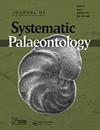美国怀俄明州上侏罗统莫里森组发现的一具近乎完整的新似显龙骨架,为研究颈头类动物的进化和多样性提供了线索(爬行纲:鳞翅目)
IF 2.2
2区 地球科学
Q3 EVOLUTIONARY BIOLOGY
引用次数: 6
摘要
我们描述了一种来自美国怀俄明州上侏罗统莫里森组的小型喙头类爬行动物,Opisthiamimus gregori gen. et sp. nov.。尽管许多舌头动物化石是基于孤立的不完整的颌骨,但o.g regori的完整型包括了大部分头骨和头盖骨,因此代表了北美已知的最完整的舌头动物标本之一。我们使用微型计算机断层扫描来详细检查其骨骼解剖结构,并开发了头骨的三维重建。O. gregori的头骨与一些非新颅齿目喙头类动物的头骨相似,如平头龙(如大轨道)和Clevosaurus(如顶骨副柱头嵴),但也显示出一系列与原始剪切机制相关的其他特征,这些特征在更多的系统上嵌套的分类群中得到了越来越多的阐述,如蝶龙(如腭侧齿排沿着整个长度与上颌齿排平行)。金字塔形的无齿齿具中部的剪切冠)。O. gregori的颅后骨骼表现出陆生喙头类动物的典型特征。我们的系统发育分析使用了118个字符和46个分类群的更新数据集,以及最大简约和贝叶斯框架。结果表明,格里戈瑞氏在尤显亚内,但在新显亚外,因此对嵌套更深的Clevosauridae、Sphenodontidae和Pleurosauridae等分支的特征极性有重要影响。我们还建立了Leptorhynchia分类群nov.,该分类群主要由水适应分类群(如胸骨龙、嘴龙)组成,并得到了颅骨和后颅骨特征的支持。由于O. gregori与其他已命名的Morrison rhynchocephalis(如Opisthias rarus)并没有特别密切的关系,因此它增加了该地层内α和β的分类多样性。同样,莫里森类群在体型和推断饮食上的主要差异表明,在侏罗纪末期全球喙头类动物多样性大幅下降之前,它们的古生态多样性相当可观。http://zoobank.org/urn:lsid:zoobank.org:pub:888E055B-8AC1-4BD0-A37C-8CB192F79673本文章由计算机程序翻译,如有差异,请以英文原文为准。
A nearly complete skeleton of a new eusphenodontian from the Upper Jurassic Morrison Formation, Wyoming, USA, provides insight into the evolution and diversity of Rhynchocephalia (Reptilia: Lepidosauria)
We describe a new, small-bodied rhynchocephalian reptile, Opisthiamimus gregori gen. et sp. nov., from the Upper Jurassic Morrison Formation of Wyoming, USA. Whereas many fossil rhynchocephalians are based on isolated incomplete jaws, the holotype of O. gregori includes most of the skull and postcranium and therefore represents one of the most complete specimens of Rhynchocephalia known from North America. We used micro-computed tomography to examine its skeletal anatomy in detail and to develop a three-dimensional reconstruction of the skull. The skull of O. gregori is similar to that of several non-neosphenodontian rhynchocephalians such as Planocephalosaurus (e.g. large orbits) and Clevosaurus (e.g. parietal parasagittal crests) yet exhibits a suite of other features related to the proal shearing mechanism that becomes increasingly elaborated among more phylogenetically nested taxa such as Sphenodon (e.g. lateral palatine tooth row parallels maxillary tooth row along its entire length, pyramidal dentary teeth with mesial shearing crests). The postcranial skeleton of O. gregori exhibits characteristics typical of a terrestrial rhynchocephalian. Our phylogenetic analyses use a substantially updated data set of 118 characters and 46 taxa, and both maximum parsimony and Bayesian frameworks. Results place O. gregori inside Eusphenodontia but outside Neosphenodontia, and therefore in a key position for contributing to character polarity for more deeply nested clades such as Clevosauridae, Sphenodontidae and Pleurosauridae. We also erect Leptorhynchia taxon nov., composed primarily of aquatically adapted taxa (e.g. Pleurosaurus, Sapheosaurus), which is supported by both cranial and postcranial characters. Because O. gregori is not particularly closely related to the other named Morrison rhynchocephalians (e.g. Opisthias rarus), it increases both the alpha and beta taxonomic diversities within the formation. Similarly, major differences in body size and inferred diet of the Morrison taxa imply considerable concomitant palaeoecological diversity just prior to a major global decline in rhynchocephalian diversity around the close of the Jurassic. http://zoobank.org/urn:lsid:zoobank.org:pub:888E055B-8AC1-4BD0-A37C-8CB192F79673
求助全文
通过发布文献求助,成功后即可免费获取论文全文。
去求助
来源期刊
CiteScore
5.30
自引率
7.70%
发文量
31
审稿时长
>12 weeks
期刊介绍:
The Journal of Systematic Palaeontology publishes papers that provide novel and impactful results in phylogenetics and systematics and that use these results in ways that significantly advance rigorous analyses of palaeogeography, palaeobiology, functional morphology, palaeoecology or biostratigraphy. Papers dealing with theoretical issues or molecular phylogenetics are also considered if they are of relevance to palaeo-systematists. Contributions that include substantial anatomical descriptions, descriptions of new taxa or taxonomic revisions are welcome, but must also include a substantial systematics component, such as a new phylogeny or a revised higher-level classification. Papers dealing primarily with alpha-taxonomic descriptions, the presentation of new faunal/floristic records or minor revisions to species- or genus-level classifications do not fall within the remit of the journal.

 求助内容:
求助内容: 应助结果提醒方式:
应助结果提醒方式:


